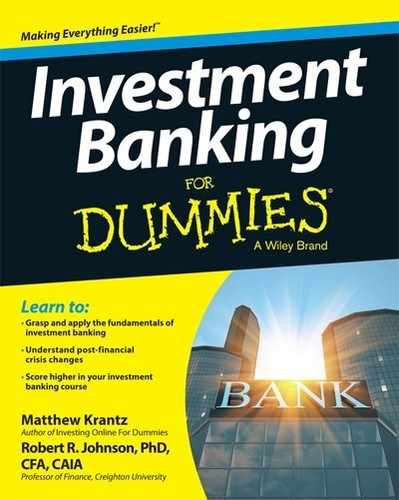Book Description
Enrich your career with a review of investment banking basics
One of the most lucrative fields in business, investment banking frequently perplexes even banking professionals working within its complex laws. Investment Banking For Dummies remedies common misconceptions with a straightforward assessment of banking fundamentals. Written by experts in stock market proceedings, this book runs parallel to an introductory course in investment banking. It clearly outlines strategies for risk management, key investment banking operations, the latest information on competition and government regulations, and relationships between leveraged buyout funds, hedge funds, and corporate and institutional clients. With this reference, you can ace investment banking courses and grasp the radical changes that have revamped the stock market since the financial crisis.
Thoroughly addresses the dramatic financial changes that have occurred in recent years
Outlines expectations to prepare you for the future
Teaches the practical aspects of finance and investment banking, how to value a company, and how to construct a financial model
No serious business student or banking professional should be without the basic knowledge of issuing bonds, stocks, and other financial products outlined in this excellent resource.
Table of Contents
- Introduction
- Introduction
- Part I: Getting Started with Investment Banking
- Chapter 1: Introducing Investment Banking
- Chapter 2: The Purpose of Investment Banking: What Investment Bankers Do
- Chapter 3: How Investment Bankers Sell Companies
- Chapter 4: How Investment Banking Is Used in Mergers and Acquisitions
- Chapter 5: How Investment Banking Is Used in Leveraged Buyouts
- Part II: Digging In: Performing Investment Banking
- Chapter 6: Finding the Data: Documents and Reports
- Chapter 7: Making Sense of Financial Statements
- Chapter 8: Perfecting the Financial Ratios for Investment Banking
- Chapter 9: Sizing Up the Industry
- Chapter 10: Understanding Stocks and Focusing on Past Transactions
- Chapter 11: Applying Investment Banking to Fixed Income
- Part III: Taking Investment Banking to the Next Level
- Chapter 12: Doing a Discounted Free Cash Flow Analysis
- Chapter 13: Structuring a Leveraged Buyout
- Chapter 14: Determining the Strength of a Company's Return on Equity
- Part IV: Applying Investment Banking
- Chapter 15: Knowing the Rules
- Chapter 16: Seeing How Some Companies Lie, Cheat, and Steal Their Way to the Top
- Chapter 17: Understanding Alternative Investments and Asset Management
- Chapter 18: Trying Your Hand at Investment Banking with a Case Study
- Part V: The Part of Tens
- Chapter 19: Ten of the Biggest Debacles in Investment Banking History
- The Dot-Com Boom and Bust
- Tainted Research Scandals
- Enron and the Accounting Scams
- The Mortgage Debacle and Collapse of Lehman
- The Flash Crash
- The London Whale at JPMorgan and Barings Bank
- Long-Term Capital Management
- Bankruptcy in Jefferson County, Alabama
- IPO Allocations with CSFB
- Bad Mergers and Acquisitions Like AOL Time Warner
- Chapter 20: Ten Ways to Improve a Discounted Cash Flow Analysis
- Financial Analysis Isn't Physics
- Show Your Sensitive Side
- Monte Carlo Isn't Just for High Rollers
- What Can Go Wrong Will Go Wrong
- It's Tough to Make Predictions, Especially about the Future
- The Investor of Today Doesn't Profit from Yesterday's Growth
- Garbage In, Garbage Out
- Rates Are Falling — It's a Better Deal!
- Read Your Putt from Several Angles
- The Weighting Is the Hardest Part
- Chapter 21: Ten (Or So) of the Best Online Resources for Investment Bankers
- Appendix: Where Investment Banking Came From
- Chapter 19: Ten of the Biggest Debacles in Investment Banking History
- About the Authors
- Cheat Sheet
- More Dummies Products
